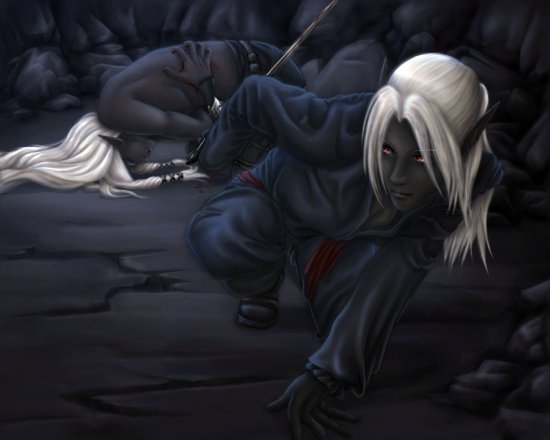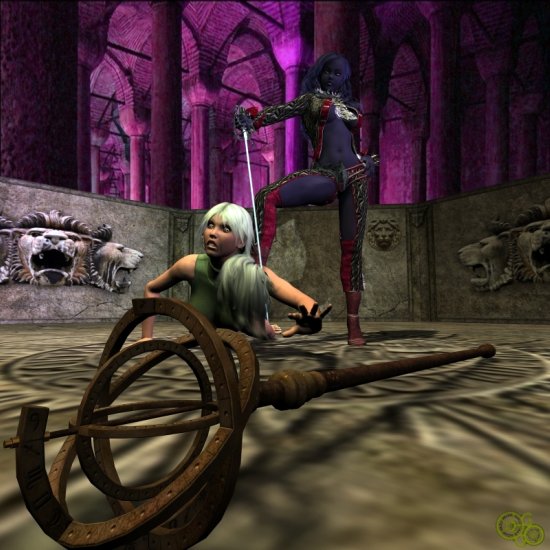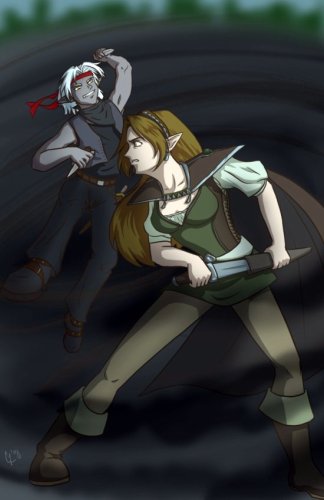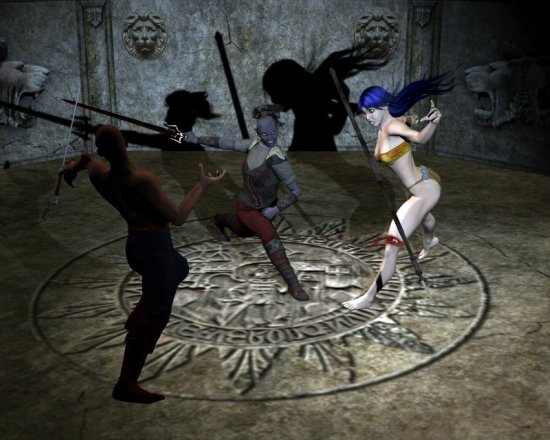
©2004 Jenny Dolfen
Most people who live along the Sword Coast know of Drizzt Do'Urden, master of the two scimitars. The foolish and ignorant might assume that his style of fighting is the most common style among drow of the Underdark. But drow come from many different cities, worship many different gods, and have just as many varied influences in their lives as humans, surface elves, or dwarves. As such, their fighting styles vary from city to city and from individual to individual. Since most drow cities have a martial academy that all warriors must attend, all drow gain a basic familiarity with many styles of combat, from subtle twists of a blade to disarm a foe to overpowering strikes made to bite deep into enemy flesh. Here's an overview of the most common fighting styles used by the dark elves. Most drow focus on one particular style in their studies, but more experienced fighters often dabble in other styles so that they are more versatile.
- Bautha Z'hin

©2009 art by AzraelEvangeline
Vesz'aun Auvryath and Rizzen Cormrael
DO NOT TAKE, permission NOT granted!
The bautha z'hin style, which means "dodge and walk," relies on the natural agility and light armor the dark elves favor. The drow surround their foes and attack foes from all sides, and they use this style particularly against strange monsters with many attacks and a long reach. The style emphasizes dodging blows and high maneuverability, and practitioners of this style often learn the early elements of the orb alur style, bragging that they never are touched in a fight. Warriors of this style are usually paired with those using the z'ress a'thalak style, especially since the latter act as an anchor and the former position themselves to flank the enemy. This style is favored by drow rogues and fighter/rogues, as well as clerics of Eilistraee and Vhaeraun.
D&D Feats: Dodge, Mobility, Spring Attack.
- Draa Velve
Only a few dark elves in each city practice the draa velve style because the natural ability needed for this style is very rare. The name means "two sword," and it involves an amazing balance of control between the two hands. Followers of this style fight with a weapon in each hand and use one of the weapons to parry as well as attack, which means the parrying weapon also acts much like a shield. Some dark elves without perfect balance in both hands study the basics of this style, hoping to eventually master it through intense training or magic. Drizzt Do'Urden is a master of this style since he has the natural talent and also because he received training by a house weapon master.
D&D Feats: Twin Sword Style, Two-Weapon Fighting.
- Jivvin Golhyrr

©2009 art by grillghod
DO NOT TAKE, permission NOT granted!
Similar in some ways to the kyorlin plynn style, the jivvin golhyrr style is a defensive style that relies on weaknesses in the enemy's performance to cause them to stumble and fall, making them more vulnerable to later attacks and emulating a position of weakness. The name means "amusing trick" and comes from the cruel drow's appreciation for placing another in the humiliating position of a slave or other subservient being. Very skilled drow like to humble their enemies before making the killing stroke, and clerics of Lolth are fond of this style for that reason. Students of the jivvin golhyrr often study the kyorlin plynn, and vice versa.
D&D Feats: Combat Expertise, Improved Trip.
- Kyone Veldrin

©2008 commissoned art by Gabrielle Long
DO NOT TAKE, permission NOT granted!
All dark elves have the ability to create darkness as a spell-like ability, and while all of them learn how to use it to surprise, annoy, and separate foes, as few of them study the style kyone veldrin, which means "alert in the shadows." Students of this style can pinpoint the location of enemies in the middle of absolute darkness and strike them with amazing accuracy despite their effective blindness. Normally teams of specialists from this style and the luth alur style group together to form special attack teams, with the kyone veldrin fighting within the globes of darkness and the luth alur shooting to death any enemies that leave the darkness.
D&D Feats: Alertness, Blind-Fight.
- Kyorlin Plynn
Conservative dark elf fighters and those who either need to capture opponents alive (usually for interrogation) or just enjoy humiliating their opponents use the kyorlin plynn style, which means "watch and take." The style uses defensive tactics and efficient methods of disarming to delay opponents and negate their ability to fight effectively. Many drow fighting groups have at least one kyorlin plynn practitioner on hand to deal with the most powerful member of an enemy team; that drow keeps the tough opponent busy until his allies have dealt with the rest of the enemy forces and can then team up to defeat the difficult opponent. Many priestesses of Lolth learn this style because they like taking captives for torture and sacrifice.
D&D Feats: Combat Expertise, Combat Reflexes, Improved Disarm.
- Luth Alur
Dark elves are as frail as surface elves, and some prefer to stay out of immediate danger when there is fighting. The luth alur style, which means "superior shooting," is perfect for them since it allows them to strike down foes with deadly accuracy without ever being in harm's way themselves. This style requires a sharp eye and steady hands. The rare drow that use a conventional bow sometimes even learn to fire more rapidly than normal, but since such a trick is very difficult with the standard dark elf ranged weapon (a hand crossbow) that such feats are rarely seen. Most dark elf war parties have at least two luth alur warriors, and in full-scale wars there are entire squadrons of warriors using this style. These warriors usually attack enemy forces from ambush.
D&D Feats: Point Blank Shot, Precise Shot, Rapid Shot, Shot on the Run.
- Orb Alur
The orb alur style combines the best elements of bautha z'hin and kyorlin plynn, and it takes a long time to master. Called the "superior spider," the style emphasizes great sweeping maneuvers that allow its practitioners to strike many opponents with minimal effort. Normally they tumble or leap their way into the middle of a group of enemies and (if successful) cut them all down with a single stroke. This has a debilitating effect on enemy morale and often leads to retreats by enemy forces; as such, practitioners of the orb alur are greatly valued by drow noble houses and receive many privileges.
D&D Feats: Combat Expertise, Combat Reflexes, Dodge, Mobility, Whirlwind Attack.
- Phindar Streeaka
The phindar streeaka style is not technically a combat style, but it's more of a mindset when entering combat. It means "mindless recklessness," and it is the name that dark elves give to the rare drow berserkers. Because it lacks finesse and exposes the underlying chaos in drow society for all to see, it is an unpopular style. Normally only smaller and more primitive colonies of drow or those who worship the strange dark elf god Ghaunadaur, master of oozes and slimes, use it. The phindar streeaka cannot use abilities that require intellect over brute force, and so many of them use the techniques common in the z'ress a'thalak style, although to say they study that style is a misnomer.
D&D Feats: None (see z'ress a'thalak style).
- Sargh'elgg
The sargh'elgg style has simple elements but requires extensive training to master. It is used with light weapons or the traditional drow rapier, and it is designed to get the most out of these weapons and the naturally superior dark elf dexterity. The name means "valor in slaying," which is an overly-inflated title created to give some measure of confidence to those whose poor skills leave this as their only choice. Some martially-minded sorcerers and wizards learn the basics of this style, and because Kiaransalee, Lolth, and Vhaeraun all have favored weapons suitable for the sargh'elgg, it is practiced by many clerics as well. This is the most common fighting style used by a typical low-rank drow guard. (Essentially, that's anyone with no more than the standard amount of training given to a dark elf common soldier.)
D&D Feats: Improved Critical, Weapon Finesse, Weapon Focus.
- Ust Sreen
The simple combat style called ust sreen, which means "first danger," emphasizes fast reactions to the appearance of enemies. Because vigilance is a constant state in drow society, this is normally a basic series of lessons taught at drow academies and is usually combined with another style, since fast reflexes aren't terribly useful when not backed up by other skills. Normally at least one drow trained in this style is present in any scouting group and carries a hand crossbow loaded with sleep poison to eliminate one opponent early before the drow's allies can react.
D&D Feats: Improved Initiative, Quick Draw.
- Z'har Thalack
The z'har thalack style, which means "riding war," was developed for the mounted dark elf patrols and deals with the difficulties and opportunities of fighting while mounted. As drow normally ride wall-crawling lizards, special tricks available to those who can maneuver in a three-dimensional manner through the Underdark put the mounted soldiers at an advantage compared to grounded troops. Berg'inyon Baenre, head of the lizard riders of house Baenre, fights with this style, which makes his death lance (a long lance crafted with powerful death magic) even more lethal.
D&D Feats: Mounted Archery, Mounted Combat, Ride-By Attack, Spirited Charge.
- Z'ress A'thalak

©2009 art by grillghod
DO NOT TAKE, permission NOT granted!
The z'ress a'thalak style, which means "force of war," is uncommon among dark elves because few have the physical strength needed to learn all of the necessary maneuvers. Students of this style sacrifice accuracy for power and learn how to cut through the body of a falling foe to strike another enemy, or even shatter enemy weapons with a single blow. Menzoberranzan's Uthegental Del'Armgo, weapon master of house Del'Armgo, was a practitioner of this style. Drow that fight this way normally prefer heavier weapons such as longswords, hammers, and axes to the lighter weapons (such as rapiers) used by most drow. Devout worshipers of Selvetarm (a male drow deity of combat worshipped only in cities that worship Lolth; he is completely overshadowed by the Spider Queen) commonly use this style.
D&D Feats: Cleave, Power Attack, Sunder.
Page Last Updated July 17, 2009
 EXCHANGE & AFFILIATE PROGRAM
EXCHANGE & AFFILIATE PROGRAM



Role Playing Games by RolePlayGateway


©2001-2022 All rights reserved Descent Into Darkness {Drow Campaign set in the Forgotten Realms}.
Everything within the domain name http://drowcampaign.roleplaynexus.com is protected by federal laws. Any duplication in part or in full, without written consent is a violation of these laws. The material such as graphics, backgrounds and music have their own Copyrights and were free to use with permission.
The material gathered and contained within is property and copyrighted to Wizards of the Coast, which is a Hasbro® owned company with its own Terms & Conditions to follow. If you wish to use any information on this site please contact the webmasters and all respective creditors mentioned in this statement. Thank you.
This site is for non-profit and commercial use is prohibited.
|


















